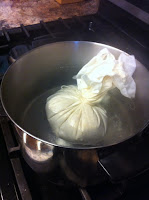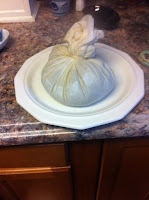The Challenge:
3. History Detective (January 29 - February 11) For this challenge, you get to be the detective! Either use clues from multiple recipes to make a composite recipe, or choose a very vague recipe and investigate how it was made.
Intro
If the fellow foodies will remember, I've set an additional challenge to interpret dishes that are listed as served at the 80th Anniversary Dinner of the Friendly Sons of St. Patrick. The
Hors d'Oeuvre course begins with "
Varies" in addition to
Bouchees de gibier.
So my search begins with what was served in an
hors d'oeuvre course and perhaps what might have appealed for this particular special meal.
From:
The French Cook; Or, The Art of Cookery: Developed in all it's branches by Louis Eustache Ude, 1815
In France, between the dormant (centre stationary dish) and the entries, it is customary to place hors-d'oeuvres, viz. sallads of anchovies, canapes, sallad dishes filled with lemons, bitter oranges, butter, radishes, turnip radishes, of figs in autumn, what we call hors-d'oeuvres de cuisine, such as saucisses, houdins, kc. &c. which indeed give a good appearance to a table. In England it is not customary to serve hors d'oeuvres, as in very few houses, they keep a confectioner, and that the hors-d'oeuvres belong to his department.
Here's an early clue,
hors d'oeuvres are a French custom not much seen in England. By extension, the United States may have been likewise slow to adopt the tradition.
It is also stated that hors d'oeuvres are made by a confectioner. So, if we'd like appropriate recipes, we should look in books for confectioners.
From:
The Domestic Dictionary and Housekeeper's Manual by Merle & Reitch, 1842
Hors D'Oeuvres Cold
Roll
Oysters
Lemon
Butter
Radishes
Thunny
Anchovy Salad
Sardines
Pate de foie gras with truffles
Melon slice
3 Figs
Cold Artichokes with vinegar and pepper
Olives
Cornichons (cucumber)
Ham
Sausage de Lyon or d'Arles
Tongue
Hors d'Oeuvres Hot
2 Fresh Eggs
Fried Battered Oysters
Scolloped Oysters
2 Sausages broiled
2 Sausages with cabbage
2 Sausages with saurkraut
Sausage with truffles
Pig's Foot broiled
Pig's Foot dressed with truffles
Black Pudding
Ham and Spinach
Pork Chop
Pork Chop with sauce Robert
Pork Chop with tomato sauce
Pork Chop with acidic sauce
Andouillette Sausage
2 Patties
Here we have a listing of
hors d'oeuvres served
a la carte at the "finest" restaurants of Paris, France. Many seem to be smaller portions of entrees and made dishes, as we see today with some appetizers.
From:
The household manager: being a practical treatise upon the various duties... by Charles Pierce, 1857
The ornaments, be they with or without a plateau, are, as usual, placed in the centre of the table, and the dessert is placed symmetrically around them; taste, at times, prefers that the hors-d'oeuvres be not placed upon the table, but be offered from the side table; and in such cases less of them in quantity are required.
Beautiful specimens of small china, or of glass dishes, can be brought into use to receive the hors-d'oeuvres, and impart at the same time increase of embellishment and ornament to the table.
The hors-d'oeuvres may be chosen from any of the following, or the like—as, fresh caviare, anchovies, pickled oysters, Dutch herrings, sardines, pickled tunny, prawns, lobsters, smoke-dried ham, and smoked salmon. The last two should be cut in very thin slices.
Our next clues of the emerging
hors d'oeuvres tradition come from a book describing a new dining tradition,
Dinner a la Russe. We learn the correct serving dish and a few dishes that were thought appropriate.
From:
The Royal Cookery Book by Jules Gaffe, 1869, page 76
HORS-D'OEUVRE IN GENERAL USE
In this Chapter I give a selected list of the hors-d'oeuvre most in use in ordinary households ; it may be objected, that these belong rather to the maitre d'hotel's department, than to the cook's ; but this will not be the case in smaller establishments, where the plain cook will have to attend to these, in addition to her ordinary work; this list of hors-d'oeuvre has therefore appeared to me to have its proper place in domestic cookery.
It is customary to dish up hors-d'oeuvre in small oval dishes or flat boats.
This source goes on to list several dishes with recipes.
I'll continue my search with other published menus of the era that list
hors d'oeuvres. In the focus of my quest, "
Bouches de gibier" or "Bites of Game" are chosen in addition to "
Varies".
From the Manhattan Club, a dinner menu from 1866 includes
Petites Bouchees, A L'imperatrice or "little bites in the style of the Empress".
The next menus that include
hors d'oeuvres listed in a similar manner come from the 1880s, which is 20 years later than I'd like to use.
So "bites of game" will be covered in a later post. For this one I'll do a few cold
hors d'oeuvres that start the meal off well.
The Recipe:
From:
The Royal Cookery Book (translated from the French) by Jules Gaffe, 1869, page 76
RADISHES
These are to be had the whole year; they should be chosen of a light red colour, small, and sound; hollow radishes are large and of a dark red. Radishes are prepared for table by cutting the leaves to a length of 1 1/2 inch; scraping off the outer skin; washing them in plenty of water, and dressing them, in a boat, with a little cold water.
OLIVES
Choose these firm and green,--the picholine are the best.
Should the olives be too salt, steep them in water for an hour; then serve them, in a boat, with cold water.
Olives that return from table should be put back in the bottle with salted water,-being careful that none remain uncovered, else they will turn black.
SARDINES
Take eight sardines out of the tin box; wipe them slightly, with a cloth; put them in a boat; garnish, with chopped parsley and capers; cover with oil,-—but on no account using that out of the box.
From:
Directions for Cookery by Eliza Leslie, 1840
To Boil PRAWNS
Throw a handful of salt into a pot of boiling water. When it boils very hard, put in the prawns. Let them boil a quarter of an hour, and when you take them out lay them on a sieve to drain, and then wipe them on a dry cloth, and put them aside till quite cold.
Lay a handful of curled parsley in the middle of a dish. Put one prawn on the top of it, and lay the others all round, as close as you can, with the tails outside. Garnish with parsley.
Eat them with salt, cayenne, sweet oil, mustard and vinegar, mixed together as for lobsters.
CELERY.
Scrape and wash it well, and let it lie in cold water till shortly before it goes to table; then dry it in a cloth, trim it, and split down the stalks almost to the bottom, leaving on a few green leaves. Send it to table in a celery glass, and eat it with salt only; or chop it fine, and make a salad dressing for it.
The Date/Year and Region:
Early to Middle 19th Century, English, French, and American use
How Did You Make It:
It was mostly plating and garnishing as directed.
Time to Complete:
30 minutes
Total Cost:
About $15.00
How Successful Was It:
I think it went very well.
How Accurate Was It:
Our tinned sardines and our shrimp/prawns are generally bought without heads, where in period the heads would have been included. Likewise the radishes were sold with the leaves already removed, where I should have used fresh cut ones. Otherwise, I think it's close.










